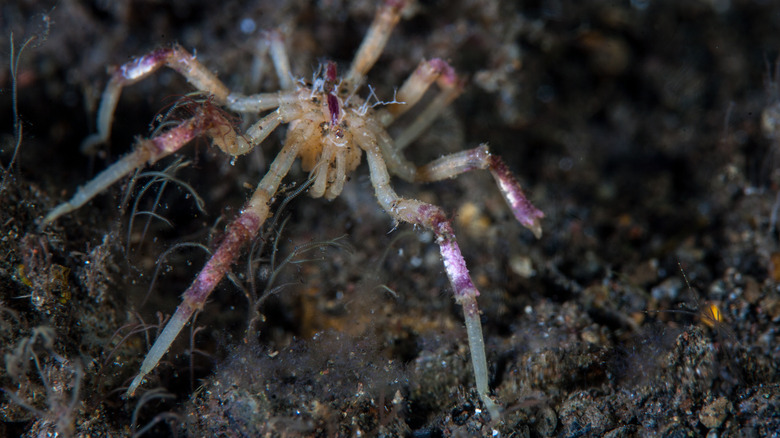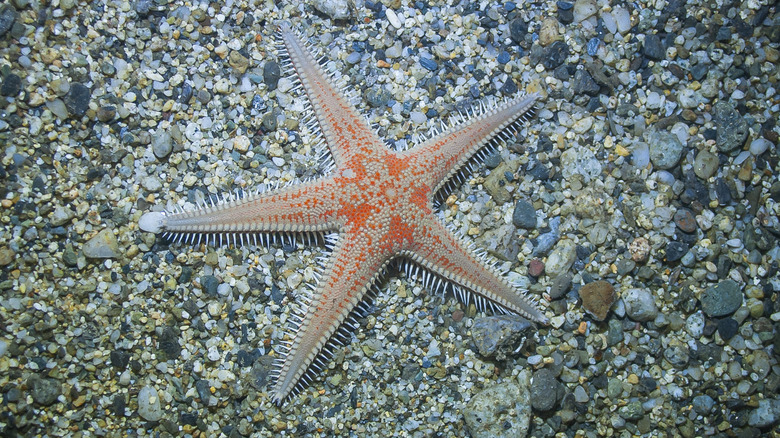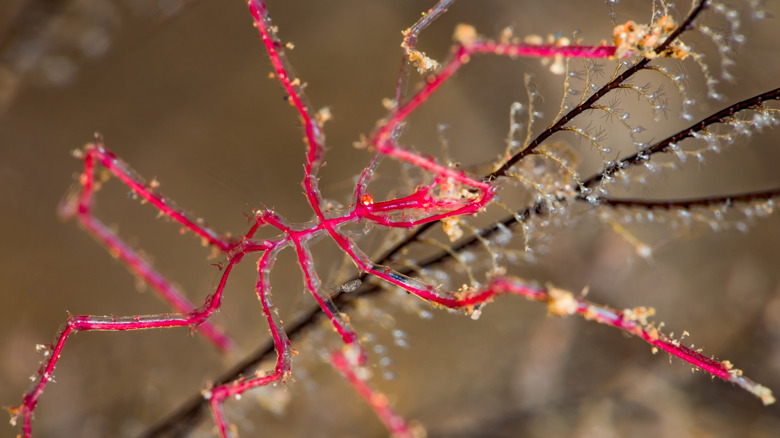How A Biologist's Mistake Led To The Discovery Of This Bizarre Sea Spider Behavior
For many humans, spiders are little more than a seasonal nuisance. They maraud into our homes in cold weather, they spin unsightly webs in awkward corners of the ceiling, they stealthily appear from out of nowhere. The classic spider move of gradually appearing in someone's eyeline by dangling down from the ceiling on an ever-lengthening strand of thread, "Mission Impossible" style, has been causing panic among humans for generations.
According to the Cleveland Clinic, up to around 15% of people have arachnophobia. These scuttling little so-and-sos come in all shapes and sizes, some of which are truly gigantic and more than worthy of such trepidation — per Guinness World Records, the largest is the goliath bird-eating spider. A specimen found in 1965 was 11 inches (28 centimeters) long.
Like all critters, though, spiders are unique, fascinating, and beautiful in their own right. Quite by chance, scientists happened upon an intriguing ability that some sea spiders have: they can regrow parts of their own bodies. Before they're fully grown, at least.
Starfish are spectacular, but sea spiders are something else
The ability to regenerate after suffering damage or injury is a truly remarkable one in the animal kingdom. It seems more of a superpower possessed by fictional heroes or particularly irritating enemies in video games, but there are real-world examples. The most iconic of them is probably the starfish.
According to the Smithsonian Science Education Center, most starfish species can regrow lost limbs. Not only that, but they can actually voluntarily use them as sort of decoys to scuttle away from danger. Some lizards can also do this, but with their tails. The process of doing so, per Australian Geographic, is known as autotomy. For the lizards, it happens because a fracture plane in their tail allows it to split away cleanly and largely harmlessly.
For a lot of spider species, regrowing one of their eight spindly legs if one happens to be lost is an impossible proposition. Some young sea spiders, however, can seemingly do something even more unique, and much more bizarre: regrow parts of their hindquarters.
Legs are just the beginning
In January of 2016, Gerhard Scholtz and Georg Brenneis published the study "The pattern of a specimen of Pycnogonum litorale (Arthropoda, Pycnogonida) with a supernumerary leg can be explained with the 'boundary mode' of appendage formation" in The Science of Nature. The study explains that arthropods, such as sea spiders, can indeed regrow limbs. "Ablation experiments of trunk segments and limbs led to an at least partial regeneration of ablated structures," the study reports of Pycnogonida.
That's just the beginning of what they can do, though. Per Science News, biologist Brenneis had one of these sea spiders in his scientific clutches while studying it. As The Science of Nature study puts it, "the animal was during transfer unintentionally damaged in the trunk region between the second and third walking legs." The spider, probably having mixed feelings about being poked and prodded by careless scientists, survived the mishap. It then went on to do something incredible.
As the sea spider was not mature at the time, its body was softer and thus more vulnerable to damage. It didn't seem perturbed by the incident, though. Months passed, and it had developed a ninth leg during the recovery process. Per the study, in pycnogonids, "internal organs such as gut diverticula and gonads are extending into the legs. This is also true for the malformed specimen described here." The sea spider not only grew an extra leg, but it also regrew some of its reproductive system.
Implications for medical science may be huge
The scientists, per The Science of Nature, noted some crucial differences between the original body parts and those that had grown afterward. "In the unharmed body half, the ovaries occupy the space lateral and dorsal to the gut throughout the trunk with its segmental lateral processes," they state, while "the area of the fused right lateral processes and the fused coxae 1 comprises a relatively large dorsal area in which no part of the ovary or oocytes can be found ... there is an open space that is only loosely filled with unspecified connective tissue."
Per the study, regeneration of body parts can easily lead to anomalies, depending on the region and the reasons for it. Nonetheless, the very fact that this creature was able to regenerate something that was so much more than just a leg is extraordinary. The scientists also explain that they don't know the extent of the original damage, so it's unclear how it influenced this growth and in what way as the sea spider grew.
The January 2023 study "The sea spider Pycnogonum litorale overturns the paradigm of the absence of axial regeneration in molting animals," from Georg Brenneis et al. (via the Proceedings of the National Academy of Sciences of the United States of America) states that this was no one-off. Following amputations of immature specimens of the Pycnogonum litorale species of sea spider, it was found that they can "regrow almost complete segments and the terminal body region, including the hindgut, anus, and musculature."



